
Pablo Ruiz Picasso was a Spanish painter, sculptor, printmaker, ceramicist and theatre designer who spent most of his adult life in France. One of the most influential artists of the 20th century, he is known for co-founding the Cubist movement, the invention of constructed sculpture, the co-invention of collage, and for the wide variety of styles that he helped develop and explore. Among his most famous works are the proto-Cubist Les Demoiselles d'Avignon (1907) and the anti-war painting Guernica (1937), a dramatic portrayal of the bombing of Guernica by German and Italian air forces during the Spanish Civil War.
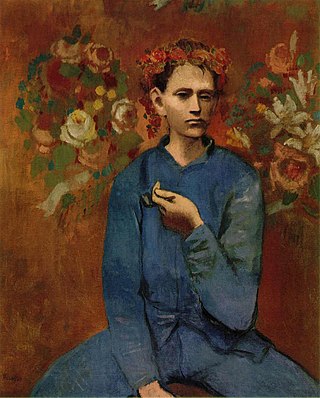
Garçon à la Pipe is an oil on canvas painting by Pablo Picasso. It was painted in 1905 when Picasso was 24 years old, during his Rose Period, soon after he settled in the Montmartre area of Paris. The painting depicts a Parisian adolescent boy who holds a pipe in his left hand and wears a garland of flowers on his head, surrounded by two floral decorations. The subject was a local boy named "P’tit Louis" who died at a young age. The painting is listed as one of the most expensive paintings, after being sold at Sotheby's auction for $104 million on 5 May 2004. It is currently the fifth highest selling painting by Picasso.
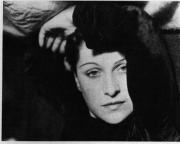
Henriette Theodora Markovitch, known as Dora Maar, was a French photographer, painter, and poet. A romantic partner of Pablo Picasso, Maar was depicted in a number of Picasso's paintings, including his Portrait of Dora Maar and Dora Maar au Chat.

Marie-Thérèse Walter was a French model and lover of Pablo Picasso from 1927 to about 1935 and the mother of their daughter Maya Widmaier-Picasso. Their relationship began when she was seventeen years old; he was 45 and married to his first wife, Olga Khokhlova. It ended after Picasso moved on to his next relationship, with artist Dora Maar. Walter is known as Picasso's "golden muse" and inspired numerous artworks and sculptures that he created of her during their relationship.

The Weeping Woman is a series of oil on canvas paintings by Pablo Picasso, the last of which was created in late 1937. The paintings depict Dora Maar, Picasso's mistress and muse. The Weeping Woman paintings were produced by Picasso in response to the bombing of Guernica in the Spanish Civil War and are closely associated with the iconography in his painting Guernica. Picasso was intrigued with the subject of the weeping woman, and revisited the theme numerous times that year. The last version, created on 26 October 1937, was the most elaborate of the series, and has been housed in the collection of the Tate Modern in London since 1987. Another Weeping Woman painting is housed at the National Gallery of Victoria and was involved in a high-profile political art theft.
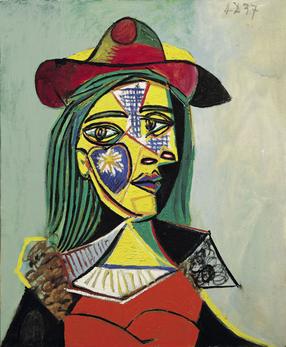
The Woman in Hat and Fur Collar is a painting by Pablo Picasso executed in 1937 and exhibited at the National Art Museum of Catalonia in Barcelona, Spain.
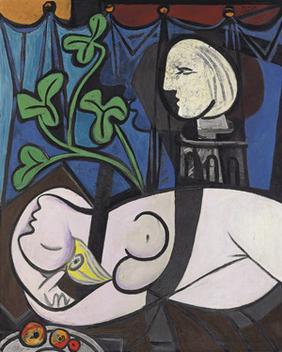
Nude, Green Leaves and Bust is a 1932 oil on canvas painting by Pablo Picasso, featuring his mistress Marie-Thérèse Walter.

La Lecture is a painting by Spanish artist Pablo Picasso completed in January 1932. The oil painting depicts Picasso's mistress and muse, Marie-Thérèse Walter, asleep with a book upon her lap. The painting led to the breakup of Picasso's marriage to Olga Khokhlova after she saw it at a retrospective exhibition and realised that the facial features were not her own. The painting went to auction in 1989 and in 1996, where it failed to sell. In January 2011, it was announced that La Lecture would be going to auction on 8 February. The painting, which had not been seen in Europe since the exhibition, was then displayed at Sotheby's in Paris.

Tête de femme is a plaster-modelled, bronze-cast sculpture by Pablo Picasso. Dora Maar, Picasso's lover at the time, was the subject of the work which was originally conceived in 1941. Four copies of the bust were cast in the 1950s, several years after the relationship ended.
Woman in a Red Armchair is an oil on canvas painting by artist Pablo Picasso. It was painted in 1929 and is housed at the Menil Collection in Houston, Texas. The painting was influenced by Surrealism and may be a portrait of Picasso's first wife, Olga Khokhlova, whom he married in 1918. It was vandalised while on display in 2012, but quickly restored.

Woman with Flowered Hat is a 1963 pop art painting with Magna on canvas by Roy Lichtenstein. The work is based on a Pablo Picasso portrait of Dora Maar. In May 2013, it sold for a record price for a Lichtenstein work.

Au Lapin Agile is a 1905 oil on canvas painting by Pablo Picasso. It depicts the interior of the Lapin Agile, a famous cabaret club in the Montmartre area of Paris. The composition was produced during Picasso's Rose Period and includes a self-portrait of the artist who frequented the club in his youth. The painting is listed as one of the most expensive paintings after achieving a price of $40.7 million at Sotheby's auction on 27 November 1989. It is housed in the collection of the Metropolitan Museum of Art in New York City.
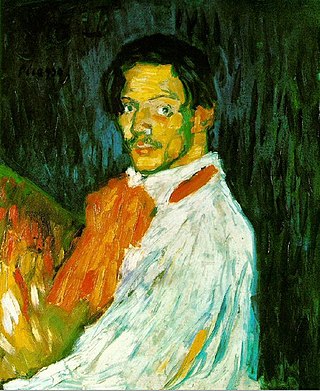
Yo, Picasso, is an oil-on-canvas painting by Pablo Picasso, which he painted in 1901. It is a self-portrait of the artist that depicts him in his youth, aged 19. The painting was created at the beginning of Picasso's Blue Period. On 9 May 1989, the painting sold at Sotheby's, achieving a price of $47.85 million, making it one of the most expensive paintings sold up to that date.

María de la Concepción "Maya" Widmaier-Picasso, later known as Maya Ruiz-Picasso, was the eldest daughter of Spanish painter Pablo Picasso and Marie-Thérèse Walter. She devoted part of her life to the study and preservation of the legacy of her father.
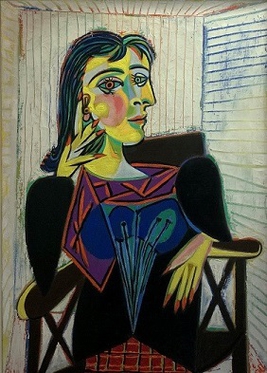
Portrait of Dora Maar is a 1937 oil on canvas painting by Pablo Picasso. It depicts Dora Maar,, the painter's lover, seated on a chair. It is part of the collection of the Musée Picasso, in Paris, where it is considered to be one of Picasso's masterpieces.

Le Repos is an oil-on-canvas painting created by Pablo Picasso in 1932. It depicts a portrait of Marie-Thérèse Walter, the artist's lover and muse, in a sleeping pose. The painting was produced in the midst of their relationship and is a demonstration of Picasso's love for his mistress. Le Repos was one of a series of sleeping portraits of Walter that Picasso created in 1932. On 14 May 2018, the painting achieved a value of $36.9 million when it was sold at Sotheby's auction.

Femme au Chien is an oil-on-canvas painting by Pablo Picasso, which he painted in 1962. It is a portrait of Picasso's second wife, Jacqueline Roque, and their dog Kaboul, an Afghan Greyhound. The painting is an illustration of the great affection that Picasso displayed for both of the subjects in the portrait and has elements of the cubist style that he pioneered. It was produced in Picasso's later years when the couple was living at Notre-Dame-de-Vie, near Mougins, France. On 14 May 2019, it was sold at Sotheby's auction for almost $55 million and is now housed in the collection of Wynn Fine Art in Florida.

Femme au béret et à la robe quadrillée is an oil-on-canvas painting by Pablo Picasso, which he created in 1937. It is a portrait of Marie-Thérèse Walter, Picasso's lover and muse during this period and was created with elements of Cubism. The painting signifies a transition in their relationship by combining Walter's profile with that of Picasso's new lover, the Surrealist photographer Dora Maar, with whom he began a relationship in 1935. This portrait was produced in the same year as Guernica and The Weeping Woman, a significant phase in Picasso's artistic career. On 28 February 2018, it was sold at Sotheby's auction for £49.8 million, making it one of the most expensive paintings ever sold at an auction in Europe.
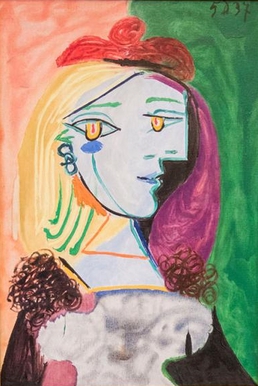
Girl with a Red Beret and Pompom is a 1937 painting by Pablo Picasso. It hangs in the main reception area of the private member's club Annabel's in Berkeley Square in London's Mayfair district.


















